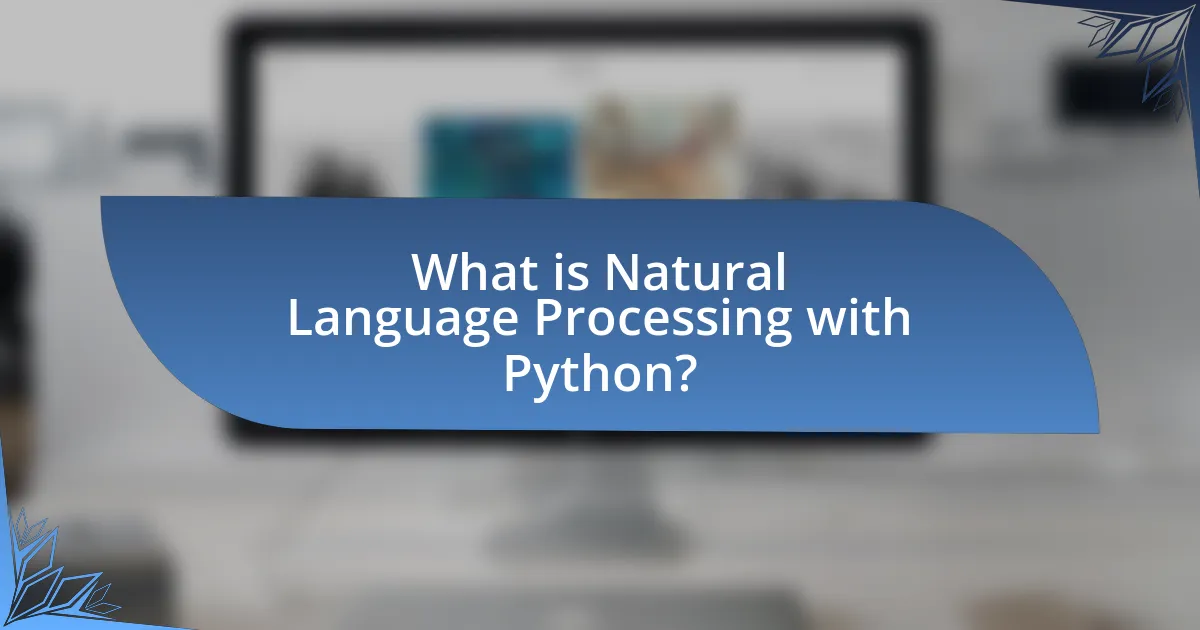Natural Language Processing (NLP) with Python involves the application of computational techniques to analyze and synthesize human language using the Python programming language. The article covers the functionality of NLP in Python through libraries such as NLTK, SpaCy, and TextBlob, which facilitate tasks like tokenization, part-of-speech tagging, and sentiment analysis. Key components of NLP, including named entity recognition and text classification, are discussed, along with the interaction of these components within Python’s ecosystem. The article also highlights the popularity of Python for NLP due to its simplicity, extensive libraries, and community support, while addressing challenges and limitations faced in NLP implementations. Practical tips for getting started with NLP in Python are provided, emphasizing best practices and continuous learning to enhance model performance.

What is Natural Language Processing with Python?
Natural Language Processing with Python is the application of computational techniques to analyze and synthesize natural language and speech using the Python programming language. Python provides libraries such as NLTK, SpaCy, and TextBlob, which facilitate tasks like tokenization, part-of-speech tagging, and sentiment analysis. These libraries are widely used in the field due to their ease of use and extensive documentation, making Python a popular choice for researchers and developers in Natural Language Processing.
How does Natural Language Processing function in Python?
Natural Language Processing (NLP) functions in Python through the use of libraries and frameworks that facilitate text analysis and manipulation. Libraries such as NLTK (Natural Language Toolkit), spaCy, and TextBlob provide tools for tasks like tokenization, part-of-speech tagging, and sentiment analysis. For instance, NLTK offers a comprehensive suite of resources for linguistic data processing, while spaCy is optimized for performance and ease of use in production environments. These libraries utilize algorithms and models that can process and understand human language, enabling applications such as chatbots, language translation, and text summarization. The effectiveness of NLP in Python is evidenced by its widespread adoption in both academic research and industry applications, demonstrating its capability to handle complex language tasks efficiently.
What are the key components of Natural Language Processing in Python?
The key components of Natural Language Processing (NLP) in Python include tokenization, part-of-speech tagging, named entity recognition, sentiment analysis, and text classification. Tokenization involves breaking text into individual words or phrases, which is essential for further analysis. Part-of-speech tagging assigns grammatical categories to words, helping to understand their roles in sentences. Named entity recognition identifies and classifies key entities in text, such as names and locations. Sentiment analysis evaluates the emotional tone behind words, providing insights into opinions and attitudes. Text classification categorizes text into predefined labels, facilitating organization and retrieval. These components are foundational for building NLP applications using libraries like NLTK, SpaCy, and Transformers, which provide tools and algorithms to implement these functionalities effectively.
How do these components interact within Python’s ecosystem?
In Python’s ecosystem, components such as libraries, frameworks, and tools interact seamlessly to facilitate Natural Language Processing (NLP) tasks. Libraries like NLTK and spaCy provide essential functionalities for text processing, while frameworks like TensorFlow and PyTorch enable the development of machine learning models. These components work together by allowing data to flow from preprocessing stages, handled by libraries, into model training and evaluation processes managed by frameworks. For instance, NLTK can tokenize text, which is then fed into a TensorFlow model for training, demonstrating the interconnectedness of these tools in executing complex NLP tasks efficiently.
Why is Python a popular choice for Natural Language Processing?
Python is a popular choice for Natural Language Processing due to its simplicity and extensive libraries. The language’s clear syntax allows developers to write and understand code quickly, which accelerates the development process. Additionally, Python boasts powerful libraries such as NLTK, SpaCy, and Transformers, which provide pre-built functions and models specifically designed for NLP tasks. These libraries facilitate tasks like tokenization, parsing, and sentiment analysis, making it easier for developers to implement complex NLP solutions. Furthermore, Python’s strong community support and continuous updates ensure that it remains relevant and equipped with the latest advancements in NLP technology.
What libraries and frameworks does Python offer for Natural Language Processing?
Python offers several libraries and frameworks for Natural Language Processing, including NLTK, SpaCy, and Transformers. NLTK (Natural Language Toolkit) provides tools for text processing, classification, and tokenization, making it a foundational library in NLP. SpaCy is designed for efficiency and production use, offering features like named entity recognition and dependency parsing. Transformers, developed by Hugging Face, enables the use of state-of-the-art pre-trained models for tasks such as text generation and sentiment analysis. These libraries are widely adopted in the NLP community, evidenced by their extensive documentation and active user bases, which validate their effectiveness and reliability in various NLP applications.
How does Python’s syntax benefit Natural Language Processing tasks?
Python’s syntax benefits Natural Language Processing (NLP) tasks by providing a clear and concise structure that enhances readability and reduces complexity. This simplicity allows developers to focus on implementing algorithms and processing language data rather than getting bogged down by intricate syntax rules. For instance, Python’s use of indentation to define code blocks eliminates the need for braces or keywords, making the code more intuitive and easier to follow. Additionally, Python’s extensive libraries, such as NLTK and spaCy, leverage this straightforward syntax, enabling rapid development and experimentation in NLP projects. The combination of readability and powerful libraries makes Python a preferred choice for NLP practitioners, facilitating quicker prototyping and deployment of language models.

What are the main applications of Natural Language Processing with Python?
The main applications of Natural Language Processing (NLP) with Python include text classification, sentiment analysis, machine translation, chatbots, and information extraction. Text classification involves categorizing text into predefined labels, which is widely used in spam detection and topic categorization. Sentiment analysis assesses the emotional tone behind a series of words, commonly applied in social media monitoring and customer feedback analysis. Machine translation enables automatic translation of text from one language to another, exemplified by tools like Google Translate. Chatbots utilize NLP to understand and respond to user queries, enhancing customer service experiences. Information extraction focuses on identifying structured information from unstructured text, such as extracting names, dates, and locations from documents. These applications leverage Python libraries like NLTK, SpaCy, and TensorFlow, which provide robust tools for implementing NLP tasks efficiently.
How is Natural Language Processing used in sentiment analysis?
Natural Language Processing (NLP) is used in sentiment analysis to automatically identify and categorize emotions expressed in text data. NLP techniques, such as tokenization, part-of-speech tagging, and named entity recognition, enable the extraction of relevant features from text, which are then analyzed using machine learning algorithms to classify sentiments as positive, negative, or neutral. For instance, a study by Pang and Lee (2008) demonstrated that using NLP methods significantly improves the accuracy of sentiment classification in product reviews, showcasing the effectiveness of these techniques in understanding public opinion.
What techniques are employed for sentiment analysis in Python?
Techniques employed for sentiment analysis in Python include machine learning algorithms, natural language processing libraries, and pre-trained models. Machine learning algorithms such as Support Vector Machines (SVM), Naive Bayes, and Logistic Regression are commonly used to classify sentiment based on labeled datasets. Natural language processing libraries like NLTK and spaCy provide tools for text preprocessing, tokenization, and feature extraction, which are essential for preparing data for analysis. Additionally, pre-trained models such as BERT and VADER are utilized for their ability to understand context and nuances in language, enhancing the accuracy of sentiment classification. These techniques are validated by their widespread application in various sentiment analysis tasks across industries, demonstrating their effectiveness in extracting sentiment from textual data.
How can sentiment analysis be applied in real-world scenarios?
Sentiment analysis can be applied in real-world scenarios to gauge public opinion, enhance customer service, and inform marketing strategies. Businesses utilize sentiment analysis to analyze customer feedback from social media, reviews, and surveys, allowing them to understand consumer sentiments towards their products or services. For instance, a study by Kumar et al. (2020) in the “Journal of Business Research” demonstrated that companies leveraging sentiment analysis saw a 20% increase in customer satisfaction by addressing negative feedback promptly. Additionally, sentiment analysis aids in political campaigns by analyzing voter sentiments on social media platforms, enabling candidates to tailor their messages effectively.
What role does Natural Language Processing play in chatbots?
Natural Language Processing (NLP) is essential for chatbots as it enables them to understand, interpret, and respond to human language in a meaningful way. NLP techniques, such as tokenization, sentiment analysis, and named entity recognition, allow chatbots to process user inputs effectively, facilitating natural and coherent conversations. For instance, a study by Google demonstrated that NLP algorithms can improve chatbot accuracy in understanding user intents by over 30%, showcasing the significant impact of NLP on enhancing user experience and engagement in chatbot interactions.
How do chatbots utilize Natural Language Processing for user interaction?
Chatbots utilize Natural Language Processing (NLP) to understand and respond to user queries in a conversational manner. NLP enables chatbots to analyze user input, interpret the intent behind the words, and generate appropriate responses. For instance, techniques such as tokenization, part-of-speech tagging, and named entity recognition allow chatbots to break down sentences and identify key components, enhancing their ability to engage in meaningful dialogue. Additionally, machine learning algorithms improve the chatbot’s performance over time by learning from interactions, thereby refining their understanding of language nuances and user preferences.
What are the challenges faced when developing chatbots with Python?
Developing chatbots with Python presents several challenges, including natural language understanding, context management, and integration with external APIs. Natural language understanding is complex due to the variability in human language, requiring sophisticated algorithms to interpret user intent accurately. Context management is crucial, as chatbots must maintain the context of conversations over multiple exchanges, which can be difficult to implement effectively. Additionally, integrating chatbots with external APIs for functionalities like payment processing or data retrieval can introduce compatibility issues and require extensive testing. These challenges highlight the need for robust frameworks and libraries, such as NLTK or spaCy, to facilitate the development process.

What are the challenges and limitations of Natural Language Processing with Python?
The challenges and limitations of Natural Language Processing (NLP) with Python include issues related to data quality, computational resources, and language ambiguity. Data quality is critical, as NLP models require large, well-annotated datasets to perform effectively; poor-quality data can lead to inaccurate results. Computational resources are another challenge, as training complex models often demands significant processing power and memory, which may not be accessible to all users. Additionally, language ambiguity poses a limitation, as words can have multiple meanings depending on context, making it difficult for models to accurately interpret text. These challenges highlight the need for careful consideration of data and resources when implementing NLP solutions in Python.
What common issues arise when implementing Natural Language Processing?
Common issues that arise when implementing Natural Language Processing include data quality, ambiguity in language, and computational resource limitations. Data quality is crucial, as noisy or unstructured data can lead to inaccurate models; for instance, a study by Zhang et al. (2018) highlighted that 70% of NLP projects fail due to poor data quality. Ambiguity in language presents challenges, as words can have multiple meanings depending on context, complicating tasks like sentiment analysis. Additionally, computational resource limitations can hinder the processing of large datasets, as NLP models often require significant memory and processing power, which can be a barrier for smaller organizations.
How can data quality impact Natural Language Processing outcomes?
Data quality significantly impacts Natural Language Processing (NLP) outcomes by influencing the accuracy and effectiveness of models. High-quality data ensures that NLP algorithms can learn relevant patterns and make precise predictions, while poor data quality can lead to misinterpretations and errors in understanding language. For instance, a study by Zhang et al. (2020) demonstrated that datasets with noise and inconsistencies resulted in a 30% decrease in model performance for sentiment analysis tasks. This illustrates that clean, well-structured data is essential for achieving reliable and valid NLP results.
What are the limitations of current Natural Language Processing models?
Current Natural Language Processing models face several limitations, including a lack of understanding of context, difficulty in handling ambiguity, and challenges with low-resource languages. These models often struggle to grasp nuanced meanings and cultural references, which can lead to misinterpretations. For instance, models like BERT and GPT-3 primarily rely on large datasets that may not encompass all linguistic variations, resulting in biases and inaccuracies. Additionally, they typically require extensive computational resources, making them less accessible for smaller organizations or applications.
How can one overcome challenges in Natural Language Processing with Python?
To overcome challenges in Natural Language Processing (NLP) with Python, one can utilize libraries such as NLTK, SpaCy, and Hugging Face Transformers, which provide robust tools for text processing and model training. These libraries offer pre-built functions for tokenization, stemming, and named entity recognition, significantly reducing the complexity of implementing NLP tasks. For instance, NLTK includes over 50 corpora and lexical resources, while SpaCy is optimized for performance and ease of use, making it suitable for real-time applications. Additionally, leveraging transfer learning with pre-trained models from Hugging Face can enhance accuracy and reduce the need for extensive labeled datasets, as demonstrated by the success of models like BERT and GPT in various NLP benchmarks.
What best practices should be followed for effective Natural Language Processing?
Effective Natural Language Processing (NLP) requires several best practices, including data preprocessing, model selection, and evaluation metrics. Data preprocessing involves cleaning and normalizing text data, which enhances model performance by reducing noise and improving accuracy. Techniques such as tokenization, stemming, and lemmatization are essential for transforming raw text into a structured format suitable for analysis.
Model selection is crucial; choosing the right algorithm, such as decision trees, support vector machines, or deep learning models, directly impacts the effectiveness of NLP tasks. For instance, transformer-based models like BERT have shown superior performance in various NLP benchmarks.
Evaluation metrics, such as precision, recall, and F1-score, provide quantitative measures of model performance, allowing practitioners to assess and compare different approaches effectively. Research indicates that following these best practices leads to improved outcomes in NLP applications, as evidenced by studies demonstrating enhanced accuracy and efficiency in tasks like sentiment analysis and language translation.
How can continuous learning improve Natural Language Processing models?
Continuous learning enhances Natural Language Processing (NLP) models by enabling them to adapt to new data and evolving language patterns. This adaptability allows models to maintain high accuracy and relevance over time, as they can incorporate recent linguistic trends and user interactions. For instance, research has shown that models employing continuous learning techniques can achieve up to 20% improvement in performance metrics, such as accuracy and F1 score, compared to static models that do not update with new data. This ongoing training process ensures that NLP models remain effective in understanding and generating human language, ultimately leading to better user experiences and more accurate outputs.
What are some practical tips for getting started with Natural Language Processing in Python?
To get started with Natural Language Processing (NLP) in Python, begin by installing essential libraries such as NLTK, spaCy, and scikit-learn. These libraries provide tools for text processing, tokenization, and machine learning, which are fundamental for NLP tasks. Next, familiarize yourself with basic NLP concepts, including tokenization, stemming, lemmatization, and part-of-speech tagging, as these are foundational techniques used in various applications.
Additionally, practice by working on small projects, such as sentiment analysis or text classification, to apply your knowledge practically. Utilize online resources like tutorials and documentation from the libraries mentioned to deepen your understanding. Engaging with community forums, such as Stack Overflow or GitHub, can also provide valuable insights and support as you learn.


